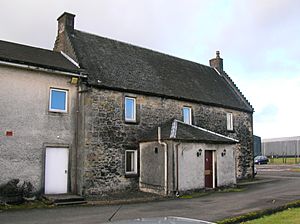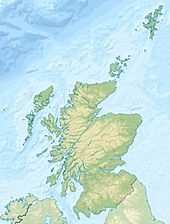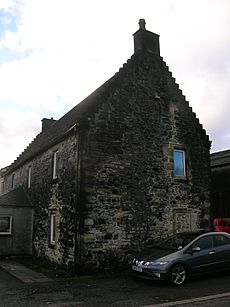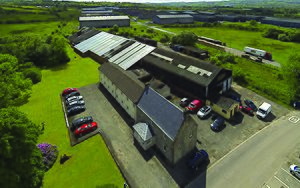Lands of Willowyard facts for kids
Quick facts for kids Lands of Willowyard |
|
|---|---|
| Beith, North Ayrshire, Scotland UK |
|

Willowyard House
|
|
| Coordinates | 55°44′50″N 4°39′14″W / 55.747148°N 4.653992°W |
| Grid reference | NS 3351153610 |
| Type | Manor House |
| Site information | |
| Owner | A business premises |
| Controlled by | Montgomery Clan |
| Open to the public |
No |
| Condition | Much modified |
| Site history | |
| Built | 18th century |
| Built by | Montgomerie family |
| Materials | Stone |
The old lands of Willowyard (also known as Willieyeards, Williyard, or Willizeards) were once part of a large area controlled by Kilwinning Abbey. They were also connected to the Barony of Beith and the Bailiary of Cuninghame. Later, the Montgomerie family owned these lands. In 1723, they sold Willowyard to the Simson family. Today, the main house is used by a business. A nearby industrial area and a whisky storage facility are also named 'Willowyards'.
Contents
The Story of Willowyard Lands
On the east side of Kilbirnie Loch, you'll find the historic lands of Willowyard. People in the area say its name like 'Williyard'. There were also several 'Mains' properties linked to it. Long ago, a church and a vicarage stood on these lands.
Who Owned Willowyard?
These lands were given to Helen, the daughter of Robert Lord Boyd. She held them for her lifetime. After her, the ownership went to the abbot and monks of Kilwinning Abbey. An old map by Blaeu, based on Timothy Pont's survey, shows the property as 'Williezeards'.
In 1559, Hugh Montgomery of Hessilhead owned the 'Williyard' lands. These were in the parish of Beith and the Kilwinning area. The lands then went to Francis Montgomerie of Giffin. Later, his nephew, Alexander, the 9th Earl of Eglinton, took ownership.
In 1723, Mr. William Simson bought the property from the Earl. He married Barbara Barclay in 1721 and Elizabeth Moore in 1726. He also married Hannah Crochet in 1736. William Simson had three daughters, Janet, Margaret, and Elizabeth, and a son named William. The elder William Simson enjoyed a fancy lifestyle. Because of this, his son William had to sell the estate in 1772 to Mr. John Ker of London.
By 1777, Mr. Ker had sold the property to Mr. John Neale of Edinburgh. In 1804, John Neale sold it to Mr. Robert Steel of Port Glasgow. John and Robert Duncan were renting the land at that time. By 1833, William Wilson, who was a descendant of Janet Simson, bought back his family's lands of Willowyards. His nephew, Alexander Shedden, later inherited them.
Willowyard House: A Historic Home
The Willowyard House you see today was built around 1727. The number '7271' is carved on the outside, but no one knows why. Around 1750, William Simson was listed as the owner. By the late 1700s, Willowyard was a busy farm. An advertisement described it as having about 175 acres of farmland. This land was divided into fifteen fields. It was rented out for £130 per year.
The property had a good house and a garden with fruit trees. There was also a malt mill and new farm buildings. A valuable quarry for flagstones and other stones had been opened. People believed there was also coal and limestone on the land. About ten acres of wood and many trees were on the farm. Belts of trees surrounded most of the property.
It is likely that William Simson built the current house in the early 1770s. When it was built, it was one of the most luxurious homes in the area. It was set in beautiful surroundings. A tree-lined path, planted by the Montgomeries, led to the house. There was also a group of old trees at the far end of the property. In 1890, three large beech trees were measured. They were 11 feet 4 inches, 10 feet, and 9 feet around.
A well-designed garden and orchard were once to the right and in front of Willowyard House. The Willowyard Burn, a small stream, ran through it. In 1893, Willowyard House was repaired inside and out. The roof was also replaced. The stone walls of the house were once covered with a rough plaster. The windows and corners were left as exposed stone. The roof was originally made of thatch.
Willowyard House Today
Today, Willowyard House is an office building. It is part of the manufacturing facility for Chemtec UK Ltd. This company is a part of the Armstrong-Chemtec Group. Armstrong-Chemtec Group is an international company. They design and make equipment for heat transfer. They have been doing this since 1946.
The Willowyard Estate
In 1820, Willowyard was a large estate of 120 acres. The owner had planted many trees. The beautiful house had a clear view of the loch. The estate sits on a type of rock called whinstone. A small quarry nearby was turned into a pretty lake. In 1820, John Neil of Edinburgh owned the estate.
By 1822, Robert Steel, an ironmaster from Port Glasgow, owned Willowyard. His lands were the 14th most valuable in the parish. They were valued at £114 per year. An 1827 map by Aitken shows the estate belonging to Robert Steel. In 1832, William Wilson, a descendant of earlier owners, bought the estate. By 1839, Alexander Shedden was noted as the owner.
The Mains Properties
In 1896, the farm buildings, known as Willowyard Mains (and later 'Main-Neil'), were separated from the main house. They formed three sides of a square. A high garden wall connected them. In 1891, the dairy area was made bigger. Other improvements were also made. Water was piped in from springs at Morishil.
The lands called 'Mains' were divided. They became 'Mains-Neil', 'Mains-Houston', and 'Mains-Marshal'. Robertson wrote that Mains-Hamilton was recently (1820) turned into a "good looking house" by Mr. Dun. However, it later went to a Mr. Houston. A farmhouse called Mains-Hamilton is shown on an 1856 map. It had an L-shaped outbuilding. This might now be part of the old coachhouse at 'The Meadows'. The farmhouse was torn down. A new house was built on its site, possibly using the old whinstone.
An old map from around 1600 shows properties called Mains-Mure, Mainshill, and Mains-Neil. Mains-Mure was shown as a tower house, like a small castle.
The 1911 map calls Mains Lodge 'Muir Lodge'. This is after William Muir, who built Mains House. The Muir family owned a tannery, a place where animal hides are made into leather. This tannery was near where the Beith Health Centre is today. They also built the Bark Mill. William Muir joined his family's tanning business in 1846. Laigh Mains, which was also torn down, was the home farm of Mains House. Dr. McCusker owned Mains House during World War II. Mr. Dewar owned it next, before it was bought and demolished.
Mid Road used to cross the Bath Burn by a shallow crossing near Mains House. Then it ran up to the town. This road is now abandoned. Only adventurous walkers use it.
Willowyard Industrial Estate
The Willowyard Industrial Estate is located between Kilbirnie Loch and the town of Beith. Whisky storage buildings were built here by Ballantyne Whisky Company in 1968. This happened after a big fire at the Cheapside Street Whisky Bond. Engraved stones with the initials of Mr. and Mrs. Muir were saved from Mains House when it was demolished around 1975. These stones are now part of a garden in the bonded area.
As mentioned, Willowyard House still stands. It has been changed into offices for Chemtec UK Ltd., a company that makes heat transfer equipment. The main railway line from Ayr to Glasgow runs below the industrial estate. In some places, it forms the eastern edge of the loch.
The Bark Mill
There was once a unique industrial building called a Bark Mill on the old lands of Willowyard. It was likely built by the Muir family, who owned Mains House. The mill was powered by the combined Mains and Bath Burns. This mill made finely ground oak bark. This bark was used in the tanneries of Beith. The bark came from old oak trees that once grew along the loch side.
Later, the mill became a furniture factory. Matthew Pollock ran it. In 1858, he started using machines to help make furniture. The location was far from everything and not convenient for workers. So, it was eventually sold to Robert Balfour.
Quick Facts
The first horse-drawn cart with wheels in the area was used at Willowyard around 1750.







